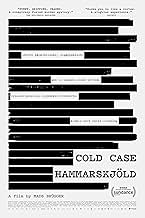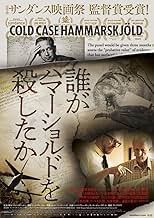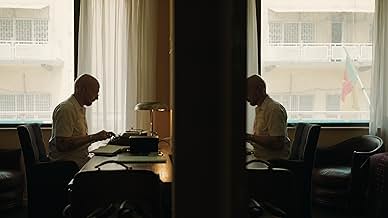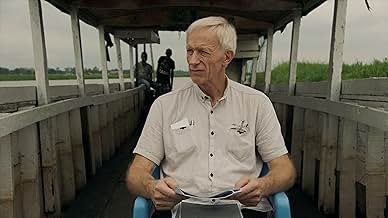Aggiungi una trama nella tua linguaDanish director Mads Brügger and Swedish private investigator Göran Björkdahl are trying to solve the mysterious death of Dag Hammarskjöld. As their investigation closes in, they discover a ... Leggi tuttoDanish director Mads Brügger and Swedish private investigator Göran Björkdahl are trying to solve the mysterious death of Dag Hammarskjöld. As their investigation closes in, they discover a crime far worse than killing the Secretary-General of the United Nations.Danish director Mads Brügger and Swedish private investigator Göran Björkdahl are trying to solve the mysterious death of Dag Hammarskjöld. As their investigation closes in, they discover a crime far worse than killing the Secretary-General of the United Nations.
- Premi
- 9 vittorie e 21 candidature totali
- Self
- (filmato d'archivio)
- Self
- (filmato d'archivio)
- Self
- (filmato d'archivio)
- Self
- (filmato d'archivio)
Recensioni in evidenza
In 1961 the secretary general of the United Nations, Dag Hammarskjold, died in a plane crash on his way to negotiate peace for a nation torn apart by apartheid. Director Mads Brugger and co-investigator Goran Bjorkdahl in Cold Case Hammarskjold craft a fascinating documentary about that crazy world in which not only does he seem to prove a plot to kill Hammarskjold, he also suggests a military group, SAIMR, is responsible for spread of HIV as a way of eradicating blacks in Africa.
"Only the subject remains noble with this gallery of suspects: It is playing safe that we create a world of utmost insecurity." Dag Hammarskjold
This undeniably interesting doc seems to suggest rightly some of the blame for the death, but the virus motif was as recently as July debunked in part by the New York Times. At least the Times has scientifically cast doubt on any group's ability to spread clinically the virus in a whole population.
As Brugger deftly transitions from the plane disaster to the virus, more bad actors appear, and the Hammarskjold murder takes a back seat, albeit the death can be seen as a strategy to take out a major player in the anti-apartheid movement. Although the motives and characters seem to multiply dazzlingly, Brugger knows how to spin the facts into engaging drama.
See this challenging doc to bone up on your African history and gain some insight into how organizations like the CIA and SAIMR operate and get away with murder. Although Angel Has Fallen beats Cold Case cold in the box office races, it can't get close to beating a doc that keeps you guessing and sometimes really leaves you cold.
"Life only demands from you the strength that you possess. Only one feat is possible; not to run away." Dag Hammarskjold
Willing to take on powerful interests in Europe who stood to gain economically from colonialism, the Secretary-General, known in Sweden as "the lord of peace," was attempting to negotiate a cease-fire between UN forces and the breakaway state of Katanga, widely considered a front for Belgian mining interests. The cause of the crash was attributed to pilot error but is considered by many to have been an assassination. The first part of the film deals with Brügger and Swedish private investigator Göran Björkdahl as they examine the circumstances surrounding the crash.
A cross between Michael Moore and Werner Herzog, Brügger tells us at the outset with tongue-in-cheek that Cold Case Hammarskjöld could either be "the world's biggest murder mystery or the world's most idiotic conspiracy theory" (though it may actually be a little of both). Separated into sections announced by yellow stickies plastered on the wall, Brügger dictates his story to two different Congolese secretaries who record it on a vintage typewriter. The two investigators initially discover from photographs that Hammarskjöld's bloodied corpse had a playing card: The ace of spades, wedged into his collar, which someone tells them is the calling card of the CIA, but that is the last we hear about it.
Ludicrously, Brügger and Björkdahl attempt to dig up the wreckage of the plane with supplies that include two shovels, a metal detector, pith helmets (a symbol of 19th century Western imperialism), and two cigars, ostensibly to celebrate after completing the job, though Björkdahl claims that he does not smoke. Brügger undertakes the project "dressed all in white like some fair bride," mimicking the appearance of a mysterious man from South Africa later deeply implicated in events. The diggers have to cut the enterprise short, however, because Brügger says that he feels nauseous but it soon dawns on us that we are being played.
The play turns deadly, however, when a man by the name of Keith Maxwell surfaces as the one who ordered Hammarskjöld's plane to be shot down by a Belgian mercenary. When a video from South Africa's post- Apartheid Truth and Reconciliation Commission is discovered, we hear about "Operation Celeste," a nine-page memo detailing plans for executing Hammarskjöld that may or may not be legitimate. On the memo's letterhead, however, is the name of the South African Institute of Maritime Research (SAIMR). Apparently, Maxwell (said by his wife to be insane) used the organization as a cover to carry out his clandestine mission.
During a period of six years, Brügger and Björkdahl interview former members of SAIMR to little benefit, but are eventually rewarded when they locate a surprisingly talkative witness, Alexander Jones, who claims that SAIMR was a mercenary group supported by the CIA and Britain's MI6. The story becomes even more chilling when Jones tells the investigators (without any evidence other than his word) that the goal of SAIMR was to eradicate black people in Africa by injecting them with the HIV virus. Though, in a New York Times article by Matt Apuzzo from January 27, 2019, we are told by scientists that this was not possible, the fact that some thought it was desirable is in itself deplorable.
In 2015, the UN reopened the Hammarskjöld investigation and a United Nations panel concluded that there was "persuasive evidence that Hammarskjöld's aircraft was subjected to some form of attack or threat." Given what we know about Western involvement in regime change such as the overthrow of Socialist President Miguel Allendé of Chile, Mohammed Mossadegh in Iran, and Jacobo Árbenz in Guatemala, Cold Case Hammarskjöld raises serious doubts about the official story. In discussing the film, Brügger said, "I want the audience to feel: I've never seen anything like this before!" My feelings exactly.
Much to his surprise as he and the other investigator quite literally dig deeper they are rewarded by a much bigger story that is actually quite shocking.
However we can't quite be sure if the super witnesses are the real thing or actors playing a part. The secondary story seems to me to be the quite serious and deserving of a follow up.
The initial story around the death of the UN's Secretary general at the time does give us more context and that part of the story has quite rightly attracted a number of headline stories.
The secondary tall tales seem quite feasible but the tone of the overall expedition / documentary seem more mockumentary like. The format seems il suited to the secondary and more mysterious context and politics.
This is very much like that moment in Jaws where the character says - "we're gonna need a bigger boat" but he does recognise this but only in an oblique way.
This discordant contrast between the jokey tone of the initial story and the wider context makes it hard to know what it is that we have just seen. At times the style is very meta with Mads Brügger ( director & one of the investigators) unsure what to do with all of the revelations.
I personally hope that some other journalists or investigators follow up on this. If the director gets to film a part 2 I'm up for it.
Lo sapevi?
- QuizDag Hammarskjold was the youngest UN secretary general for seven decades - He was a son of Hjalmar Hammarskjöld, who served as Prime Minister of Sweden from 1914 to 1917.
- ConnessioniReferenced in Film Junk Podcast: Episode 720: 47 Meters Down: Uncaged (2019)
- Colonne sonoreAlbertina
Composed by Wendo Koloboy
Performed by Wendo Koloboy as Wendo
Published by Ngoma/Sondrem
I più visti
Dettagli
- Data di uscita
- Paesi di origine
- Siti ufficiali
- Lingue
- Celebre anche come
- White Is the Colour of Death
- Luoghi delle riprese
- Aziende produttrici
- Vedi altri crediti dell’azienda su IMDbPro
Botteghino
- Lordo Stati Uniti e Canada
- 104.965 USD
- Fine settimana di apertura Stati Uniti e Canada
- 18.285 USD
- 18 ago 2019
- Lordo in tutto il mondo
- 104.965 USD
- Tempo di esecuzione2 ore 8 minuti
- Colore
- Proporzioni
- 1.78 : 1
Contribuisci a questa pagina

















